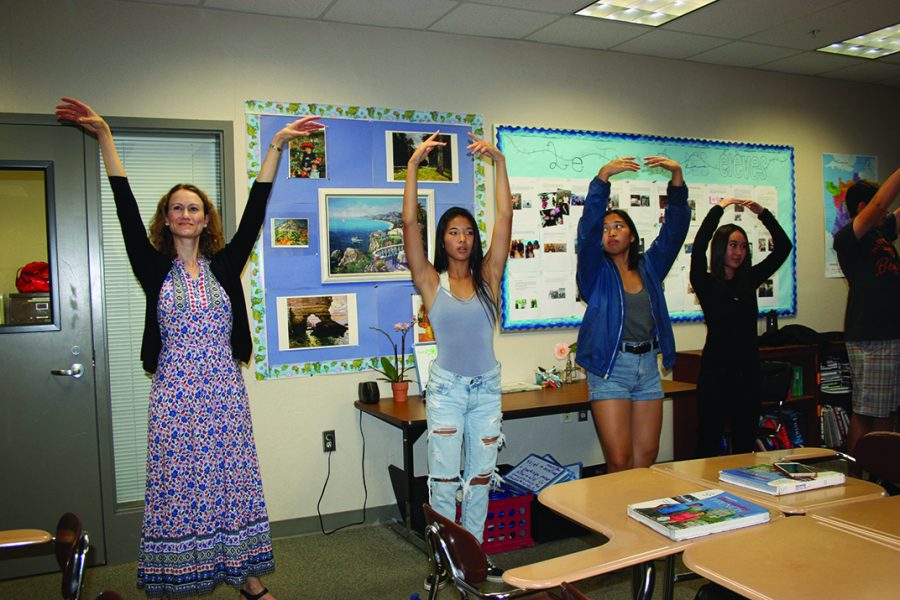Ballet brings excitement to French class
Teacher Miranda Kershaw leads French students in brief ballet lessons, where she teaches them poses along with French terms such as tendu and relevé.
Pirouettes, pliés and pointed feet. It’s all just a part of aday in Cal High French teacher Miranda Kershaw’s classes.
When the class has time, verb conjugations are left behind and the desks are cleared away to make room for ballet.
It’s a splash of color in the monotonous and tiring routine of a traditional classroom, especially in a class as demanding as foreign language.
Ballet has always been one of Kershaw’s passions. She started ballet when she was six years old and has continued to dance ever since.
Kershaw was inspired to bring in her passion to the classroom after teaching a ballet elective at a French-immersion program. While teaching, she realized the importance of ballet in the French culture, and how it could be incorporated in the classroom.
“Ballet was enhanced and codified by Louis XIV, so a lot of ballet [vocabulary] is French,” Kershaw said. “[Ballet dance moves] have a precise meaning in French. It’s fun to connect the [meaning to the dance moves].”
Through ballet, students are exposed to moves such as promenade, pliés and tendus, all action verbs that are used frequently in the French language.
While dancing, students also become familiar with words for body parts and numbers by counting.
“It’s sort of an [educational] enrichment,” said Amber Liu, a senior honors French student. “She teaches us what the French words mean.”
But ballet is not just educational. Having learned French in school, and not as a native speaker, Kershaw understands the struggles students face in learning a new language.
“I try to incorporate a variety of activities into my daily lessons and utilize different modalities for learning including visual, auditory and kinesthetic.”
said Kershaw.
To make up for the dry grammar lessons, Kershaw brings in fun aspects of French culture such as ballet. Kershaw said “it makes the class more interesting.”
“[Doing ballet] is good because it’s different,” agrees honors French student Ameya Mandale, a junior.
Initially, many students were skeptical.
“Students’ initial reactions were ‘Huh?’ and “Why are we doing this?’” said Kershaw. “But I think most of them enjoy it now.”
Many of Kershaw’s students voiced similar opinions. After a couple ballet sessions, students began to lose their embarrassment.
“It can be embarrassing but brings fun to a hard class,” said Liu.
Ballet can also be fun because it is something different to concentrate on.
“It’s definitely an engaging experience,” said junior Bruce Bantug, an honors French student.
Ballet also offers the students a chance to relax. In a school as academically focused as Cal, students can often be overstressed, especially in the honors and AP combined class that Kershaw teaches.
“Ballet gives us a break in between our projects and it’s relaxing to do,” said AP French student Samiksha Krishnamurthy, a junior.
Kershaw emphasizes the importance of relaxation and destressing in her classes.
In addition to ballet, she has a gratitude stone passed around the class. The student with the stone shares a positive comment with the class as part of Kershaw’s efforts to bring mindfulness and gratitude to the students’ lives.
“I think it’s important to focus on the present moment,” said Kershaw.
In the beginning of each class, Kershaw even has a minute of mindfulness. She rings a bowl to let its ringing sounds calm students. Many of her students seemed to appreciate the gesture.
“Madame Kershaw is a nice teacher who cares about us and [wants us to] be comfortable with the class,” said Liu.
There are clearly many benefits to ballet. But the main reasoning behind Kershaw’s mini-ballet lessons is simple.
She just wants to have fun.
“They’re all just excuses,” said Kershaw with a smile when asked about the benefits. “It’s just for fun.”






